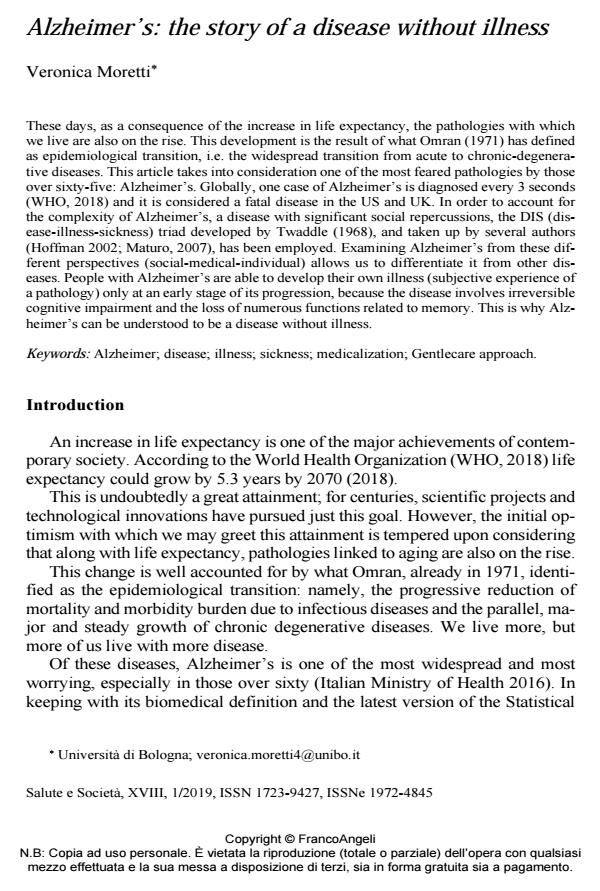Alzheimer’s: the story of a disease without illness
Journal title SALUTE E SOCIETÀ
Author/s Veronica Moretti
Publishing Year 2019 Issue 2019/1
Language English Pages 16 P. 134-149 File size 220 KB
DOI 10.3280/SES2019-001009
DOI is like a bar code for intellectual property: to have more infomation
click here
Below, you can see the article first page
If you want to buy this article in PDF format, you can do it, following the instructions to buy download credits

FrancoAngeli is member of Publishers International Linking Association, Inc (PILA), a not-for-profit association which run the CrossRef service enabling links to and from online scholarly content.
These days, as a consequence of the increase in life expectancy, the pathologies with which we live are also on the rise. This development is the result of what Omran (1971) has defined as epidemiological transition, i.e. the widespread transition from acute to chronic-degenerative diseases. This article takes into consideration one of the most feared pathologies by those over sixty-five: Alzheimer’s. Globally, one case of Alzheimer’s is diagnosed every 3 seconds (WHO, 2018) and it is considered a fatal disease in the US and UK. In order to account for the complexity of Alzheimer’s, a disease with significant social repercussions, the DIS (disease-illness-sickness) triad developed by Twaddle (1968), and taken up by several authors (Hoffman 2002; Maturo, 2007), has been employed. Examining Alzheimer’s from these different perspectives (social-medical-individual) allows us to differentiate it from other diseases. People with Alzheimer’s are able to develop their own illness (subjective experience of a pathology) only at an early stage of its progression, because the disease involves irreversible cognitive impairment and the loss of numerous functions related to memory. This is why Alzheimer’s can be understood to be a disease without illness.
Keywords: Alzheimer; disease; illness; sickness; medicalization; Gentlecare approach.
- Try to Look Again: A Phenomenological Study of Recognising Humanness in People Living With Advanced Dementia Jesper Bøgmose, Benjamin Olivares Bøgeskov, Tom Dening, Bente Martinsen, in Scandinavian Journal of Caring Sciences e70071/2025
DOI: 10.1111/scs.70071 - Implementing Twaddle Triad to Reach a New Framework for an Integrative and Innovative Medicine Davide Costa, Raffaele Serra, in Journal of Multidisciplinary Healthcare /2024 pp.4907
DOI: 10.2147/JMDH.S491021
Veronica Moretti, Alzheimer’s: the story of a disease without illness in "SALUTE E SOCIETÀ" 1/2019, pp 134-149, DOI: 10.3280/SES2019-001009